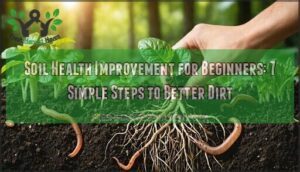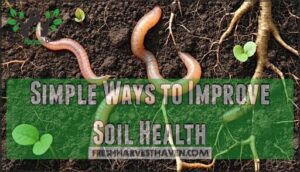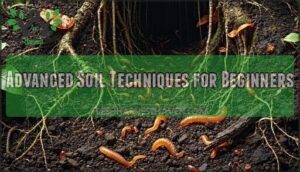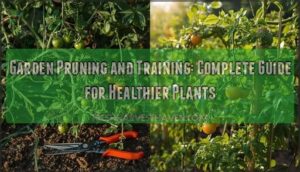This site is supported by our readers. We may earn a commission, at no cost to you, if you purchase through links.

Start with the no-dig approach, layering organic materials like compost and mulch directly on your beds.
Keep soil covered with straw, wood chips, or cover crops to prevent compaction and feed beneficial microorganisms.
Add nitrogen-fixing plants like beans and clover to naturally enrich your dirt without synthetic fertilizers.
Compost kitchen scraps regularly and mix finished compost into planting areas to create a thriving ecosystem that your plants crave.
These foundational steps can accelerate your soil transformation, but there’s more to discover about advanced techniques.
Table Of Contents
- Key Takeaways
- What is Soil Made Of?
- Why Soil Composition Matters
- Simple Ways to Improve Soil Health
- Advanced Soil Techniques for Beginners
- Maintaining Healthy Soil Year-Round
- Frequently Asked Questions (FAQs)
- How to improve soil in a garden?
- How can soil health be improved over time?
- How do you maintain healthy soil?
- Why is soil health important?
- How do you improve soil quality?
- What is soil improvement?
- What are the 5 rules of soil health?
- How can we improve the health of soil?
- What are the 5 pillars of soil health?
- What to add to soil to make it healthy?
- Conclusion
Key Takeaways
- Start with no-dig layering – You’ll build healthier soil by adding compost and organic materials directly on top without disturbing the existing ecosystem beneath.
- Keep soil covered year-round – You’ll prevent erosion and feed beneficial microorganisms by using straw, wood chips, or cover crops instead of leaving bare ground.
- Add nitrogen-fixing plants naturally – You’ll enrich your soil without synthetic fertilizers by growing beans, peas, and clover that work with bacteria to capture nitrogen from the air.
- Compost regularly and test your soil – You’ll create thriving growing conditions by mixing finished compost into planting areas and understanding your soil’s pH and nutrient levels.
What is Soil Made Of?
Before you can improve your soil’s health, you need to understand what’s actually in that dirt beneath your feet.
Think of soil as nature’s recipe that combines weathered rock particles, decomposed plant and animal matter, countless tiny organisms, plus the water and air that keep everything alive and thriving, which can be considered as a complex ecosystem.
Weathered Rock Minerals and Organic Matter
Through mineral weathering, rocks gradually break down into sand, silt, and clay particles that form soil’s foundation.
Organic matter from decomposed plants creates nutrient-rich humus, boosting soil fertility through carbon sequestration.
This natural process transforms lifeless rock into living soil, establishing the groundwork for healthy nutrient cycling and improved soil health basics in your garden.
Conservation tillage practices enhance carbon sequestration layers, which is a crucial aspect of maintaining soil health.
Living Microorganisms and Plant Roots
Beneath your feet, countless microorganisms and plant roots form dynamic partnerships that keep soil thriving.
Your soil is a bustling underground city where tiny organisms work magic every day
Mycorrhizal networks connect plant roots through fungal threads, creating underground communication highways.
Root exudates feed beneficial bacteria, while microbial symbiosis helps plants access nutrients.
This bustling soil biome operates like a bustling city, with soil organisms trading resources through complex rhizosphere ecology interactions, showcasing microbial symbiosis.
Water, Air, and Nutrients in Soil
While microorganisms work their magic, your soil’s water retention and air porosity create the perfect environment for nutrient cycling.
You’ll find that soil water retention feeds plants during dry spells, while soil air allows root respiration and microbial activity to thrive.
These soil nutrients cycle through water and air spaces, making healthy soil possible when you improve soil health through proper management, which relies on the balance of water and air to support microbial activity.
Why Soil Composition Matters
Your soil’s composition directly impacts what you can grow and how well your plants thrive. Think of soil like a recipe – the right balance of ingredients creates gardening success, while poor ratios lead to struggling plants.
Mineral contribution from weathered rocks provides essential nutrients like phosphorus and potassium that feed your plants. When organic matter breaks down properly, it creates humus that acts like a sponge, improving water retention while releasing nitrogen gradually.
Air content determines whether roots can breathe – compacted soil with poor air circulation kills even hardy plants. Microorganism roles can’t be overstated. These tiny workers break down nutrients into forms plants can actually absorb.
Without healthy bacteria and fungi, you’re basically serving your plants food they can’t digest. A key component for plant growth is mycorrhizal fungi networks, which enhance nutrient uptake.
Understanding soil composition helps you identify what’s missing. Sandy soil drains too quickly? Add compost for better water retention. Clay soil stays waterlogged? Mix in perlite to improve air content. This knowledge transforms beginner gardening soil challenges into solvable problems with targeted soil improvement methods.
Simple Ways to Improve Soil Health
You can transform poor soil into healthy, productive dirt with just a few smart practices that work with nature instead of against it.
These methods focus on protecting and feeding your soil’s living ecosystem while avoiding common mistakes that damage soil structure, using complete concepts to improve the soil’s health.
Garden Organically With No Dig Approach
No-dig gardening transforms your backyard without breaking your back or disturbing soil life below ground.
You’ll layer organic materials like compost, leaves, and cardboard directly on top of existing soil, creating a natural mulch system.
This layering method suppresses weeds while feeding beneficial microorganisms, earthworms, and fungi that improve soil health naturally.
Different mulch types work together, building rich, fertile ground.
Avoid Leaving Soil Bare and Compaction
Bare ground acts like a welcome mat for erosion and compaction problems.
You’ll protect soil structure by maintaining continuous cover through mulch benefits and cover cropping strategies.
These soil improvement methods prevent rainfall from creating hard surface crusts while supporting beneficial microorganisms.
No-till gardening techniques combined with organic matter additions create resilient growing conditions that naturally improve soil health year-round, which is a key factor in achieving soil health.
Grow Nitrogen-Fixing Plants and Compost
Plants like beans, peas, and clover boost nitrogen fixation through root bacteria, naturally enriching your soil without synthetic fertilizers.
Start composting kitchen scraps with brown materials for compost benefits that improve soil structure. Choose beginner-friendly nitrogen-fixing species for sustainable practices.
These soil improvement methods deliver healthy soil tips while supporting soil enrichment for long-term garden success. Legumes, such as alfalfa, can substantially improve soil health by enhancing soil fertility and are a key part of sustainable practices for soil enrichment.
Mulching With Straw, Wood Chips, or Grass Clippings
After boosting nitrogen levels, you’ll want to protect your soil with organic mulch.
Straw mulch benefits include weed suppression and moisture retention, while wood chip types like hardwood decompose slowly, lasting seasons.
Grass clipping use works well for quick nutrients.
Apply mulch at proper application depth—2-3 inches prevents compaction.
Different mulch decomposition rates mean straw breaks down faster than wood chips, continuously improving soil organic matter and overall soil health practices.
Consider buying quality straw for your garden.
Advanced Soil Techniques for Beginners
Once you’ve mastered basic soil care, you can implement more sophisticated techniques that deliver professional-grade results without requiring years of experience.
These methods work with natural soil processes to create a thriving underground ecosystem that supports healthier, more productive plants.
Incorporating Biochar for Carbon Sequestration
Carbon sequestration becomes achievable when you add biochar to your garden beds.
This stable soil amendment traps atmospheric carbon for centuries while boosting soil organic matter by up to 100%.
Apply 0.5-2 kg per square meter, mixing into the top 20cm for maximum agricultural benefits and environmental impact on soil health.
Using Organic Liquid Fertilizers and Amendments
You’ll find liquid fertilizers deliver nutrients faster than solid amendments, with foliar spraying achieving 25% quicker absorption than soil application.
These natural soil amendments boost soil microorganisms while improving the soil food web through enhanced microbial activity. Many gardeners find it useful to buy seaweed products for their gardens.
Top Liquid Fertilizer Types:
- Fish emulsion – Provides 7:1:1 NPK ratio with trace minerals for robust plant growth
- Seaweed extracts – Increases drought resistance by 20% while supplying bioactive compounds
- Compost tea – Delivers 18 million beneficial microbes per milliliter for soil biology impact
Crop Rotation and Green Manures for Soil Fertility
You’ve discovered one of nature’s best soil-building partnerships.
Crop rotation breaks pest cycles while green manure and cover crops add nitrogen fixation through legumes like clover.
These rotation benefits boost soil organic matter by 15-35% over five years.
Cover cropping prevents erosion, improves soil structure, and reduces fertilizer needs by 20%.
Start simple: legumes, then root vegetables, followed by leafy greens.
To improve garden productivity, consider grouping crops by family to enhance soil organic matter and overall garden productivity with cover cropping.
Adding Perennial Plants for Continuous Cover
Perennial plants create nature’s insurance policy against soil erosion, establishing deep root systems that hold soil particles together year-round.
These permanent plantings reduce tillage needs while boosting carbon sequestration and water conservation.
Smart gardeners choose perennials for lasting soil improvement, including benefits such as:
- Deep-rooted species like comfrey and alfalfa break up compacted layers
- Ground covers prevent bare soil exposure during winter months
- Diverse plantings create habitat creation while enhancing sustainable practices through continuous cover crops benefits
Maintaining Healthy Soil Year-Round
You’ll maintain soil health throughout every season by rejuvenating containers and beds with the right amendments, while creating conditions that support beneficial soil life.
The key lies in understanding how to reuse existing soil, attract helpful organisms, and build ideal growing mediums that stay productive year after year.
Reusing Potting Soil With Compost and Perlite
Your potting soil’s second act starts with rejuvenating tired medium using one-third fresh compost mixed with existing soil.
Add perlite at a 1:4 ratio for drainage improvement while maintaining nutrient replenishment.
This soil sterilization alternative saves money and delivers compost benefits. Mix thoroughly, ensuring even distribution for ideal soil health and organic soil improvement success.
Attracting Earthworms With Organic Matter
Earthworms act like tiny soil engineers, transforming your garden into a thriving ecosystem through worm composting.
These beneficial soil organisms consume organic matter, producing nutrient-rich castings that improve soil aeration and boost decomposition rates.
Add organic mulch, kitchen scraps, and leaf litter to create an earthworm paradise.
Their tunneling enhances soil health benefits while accelerating organic soil improvement naturally, leading to a more thriving and ecosystem.
Creating Ideal Raised Bed Soil Mix With Compost and Coconut Coir
Raised beds need the right soil foundation to thrive. Creating your ideal mix combines compost and coconut coir for superior results.
Here’s your winning formula:
- Mix ratios: Blend 50% mature compost with 50% coconut coir for balanced drainage solutions and nutrient retention
- Compost types: Use two to three different compost sources to boost microbial diversity and organic matter content
- Drainage solutions: Add 10-20% perlite if your mix feels too dense, ensuring proper soil drainage improvement
This combination delivers excellent coir benefits while maintaining nutrient balance for healthy garden soil. Coco coir also offers excellent water retention, holding up to 10 times its weight in water.
Frequently Asked Questions (FAQs)
How to improve soil in a garden?
Your garden’s dirt might be sulking like a neglected houseplant, but don’t panic.
Add compost, test pH levels, incorporate organic matter, and practice crop rotation to transform your soil into thriving earth.
How can soil health be improved over time?
You’ll boost soil health by adding organic matter like compost, rotating crops to prevent nutrient depletion.
Minimizing tillage that disrupts structure, and maintaining constant ground cover through mulching or cover crops.
How do you maintain healthy soil?
Like tending a living treasure, you’ll nurture soil through consistent organic matter addition, proper watering, minimal tillage, diverse plantings, and regular testing to maintain ideal pH and nutrient levels.
Why is soil health important?
Healthy soil acts as your garden’s foundation, storing water and nutrients that plants need while filtering pollutants and supporting beneficial microorganisms that keep your growing space thriving year-round.
How do you improve soil quality?
You’ll improve soil quality by adding organic matter like compost, testing pH levels, reducing tillage, planting cover crops, rotating crops annually, and avoiding chemical overuse that disrupts beneficial microorganisms.
What is soil improvement?
Studies show 95% of Earth’s food comes from soil, making enhancement vital.
You’re basically feeding your dirt’s ecosystem through organic matter additions, proper pH management, and strategic nutrient supplementation to create thriving growing conditions.
What are the 5 rules of soil health?
You’ll need to follow five core principles: keep soil covered year-round with crops or mulch.
Minimize disturbance through reduced tillage.
Maximize crop diversity.
Maintain living roots continuously.
And integrate livestock thoughtfully to avoid overgrazing.
How can we improve the health of soil?
You’ll boost soil fertility by covering it with crops year-round, rotating diverse plants, minimizing tillage, adding organic matter like compost, and reducing chemical inputs while preventing compaction.
What are the 5 pillars of soil health?
Half of all topsoil has vanished in the past 150 years, threatening our food security.
The five pillars of soil health are: minimize disturbance, maximize cover, diversify crops, maintain living roots, and integrate livestock grazing.
What to add to soil to make it healthy?
Add compost, organic matter, and mulch to your soil.
These materials improve structure, retain moisture, and feed beneficial microorganisms.
Consider adding aged manure or leaf mold for extra nutrients and texture.
Conclusion
Transforming depleted earth into fertile ground might seem overwhelming, but soil health improvement for beginners becomes straightforward with consistent organic practices.
You’ve learned that healthy soil requires minimal intervention—just regular additions of compost, protective mulching, and nitrogen-fixing plants.
These methods work together to create sustainable growing conditions that’ll support your garden for years.
Start implementing these techniques gradually, focusing on one or two methods initially, then expand your approach as you gain confidence and experience, using organic practices.









